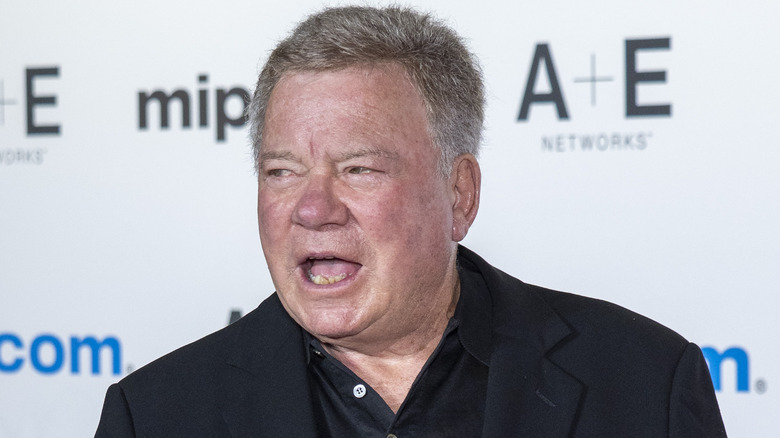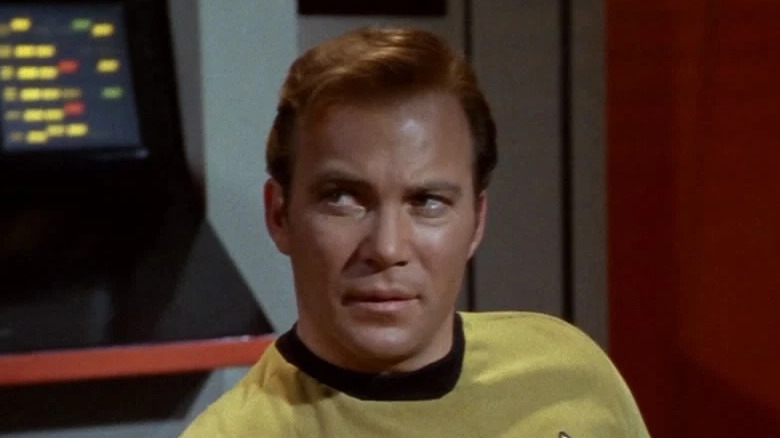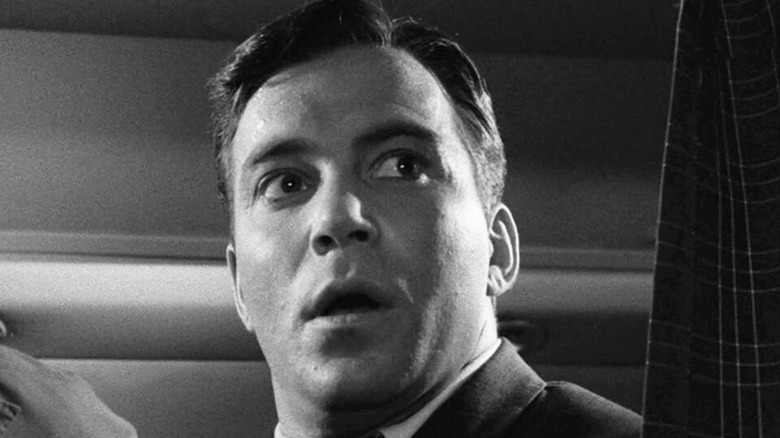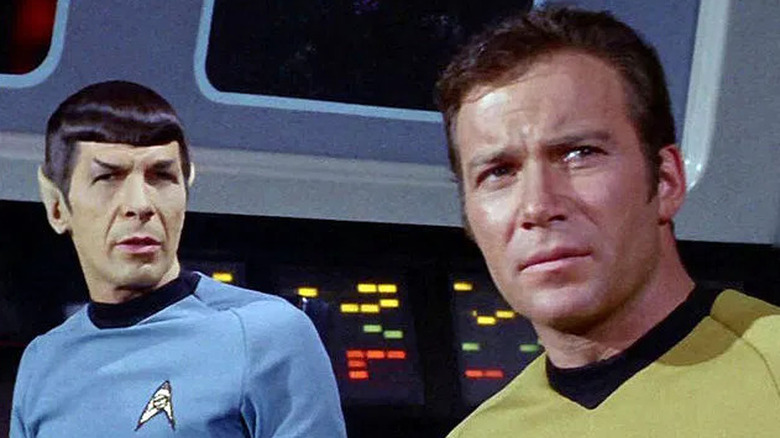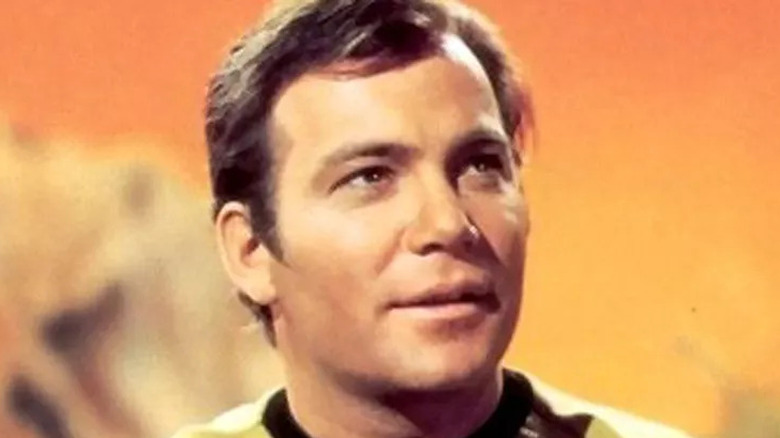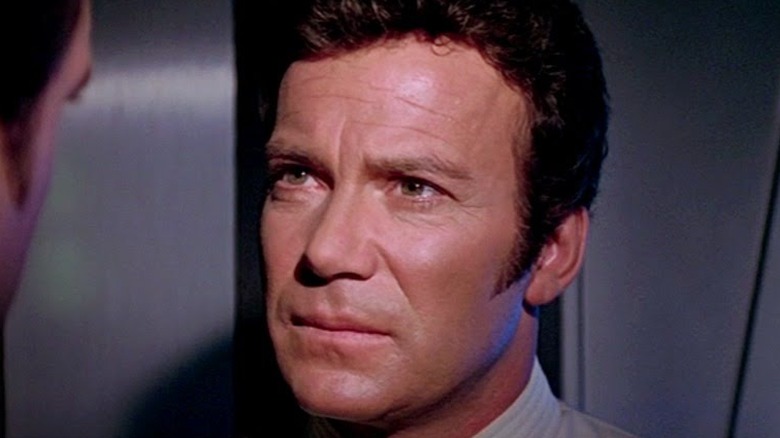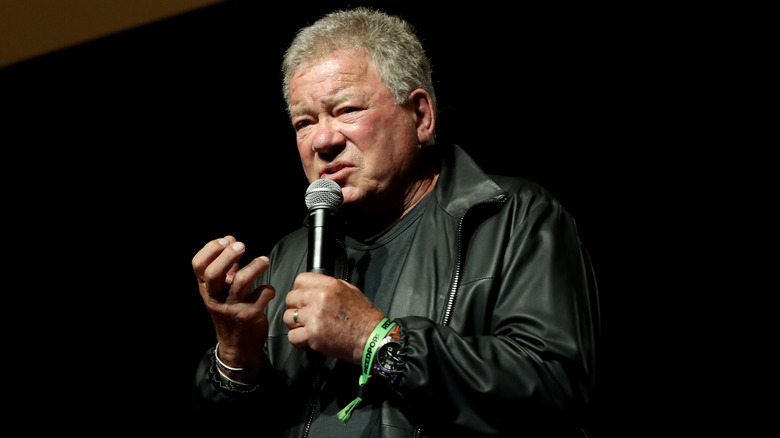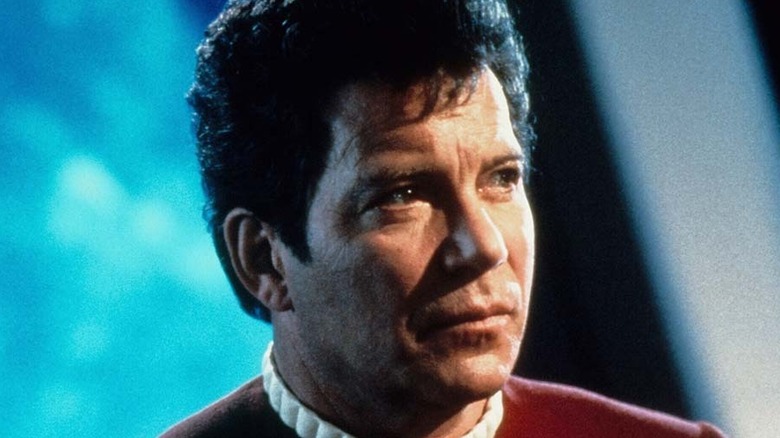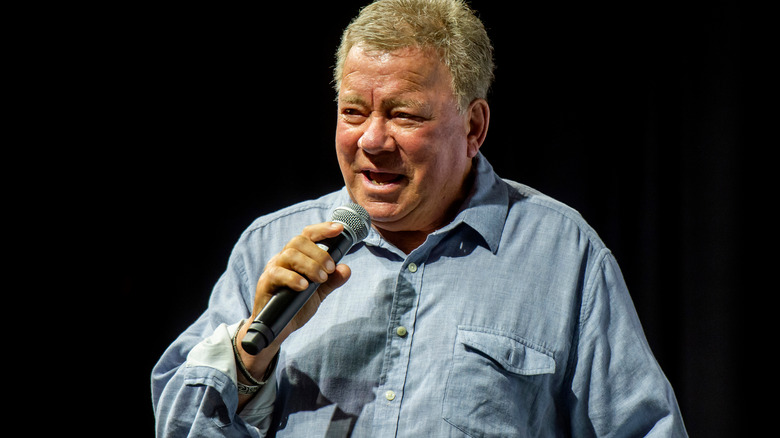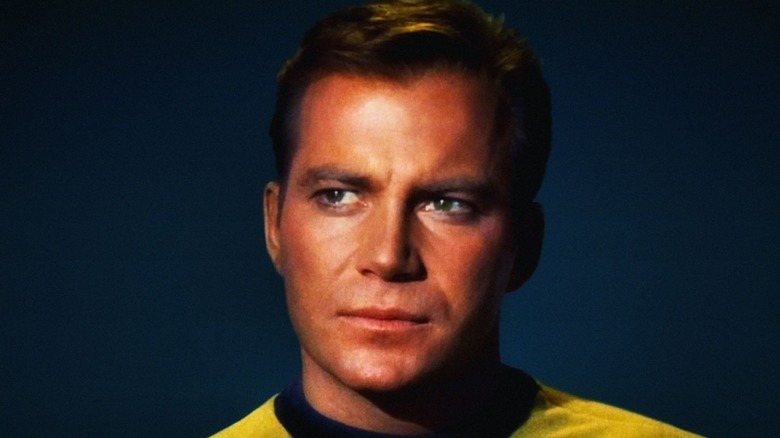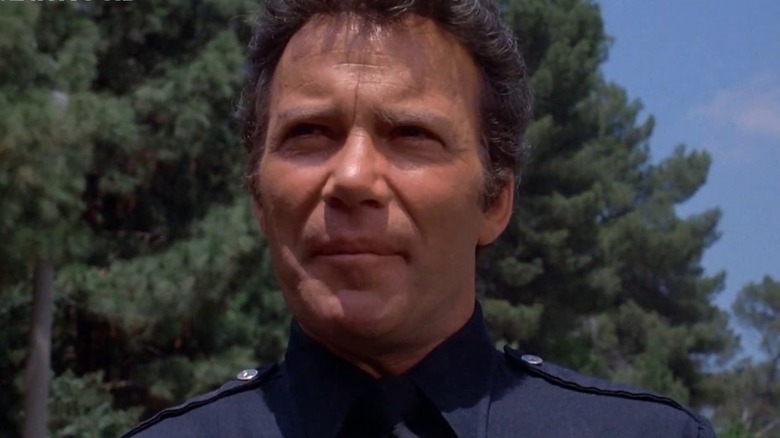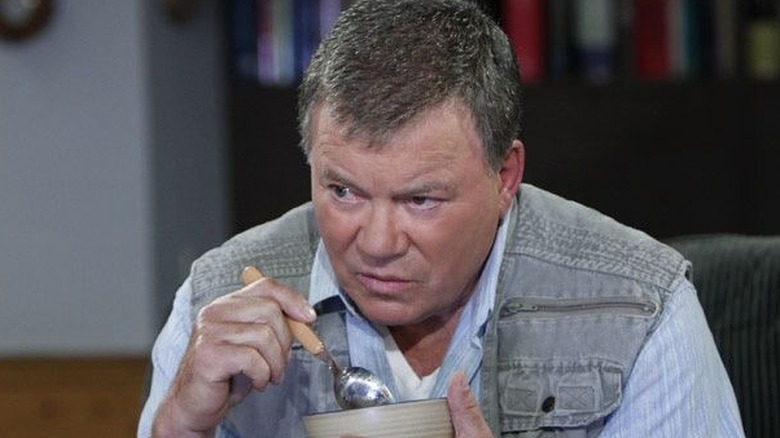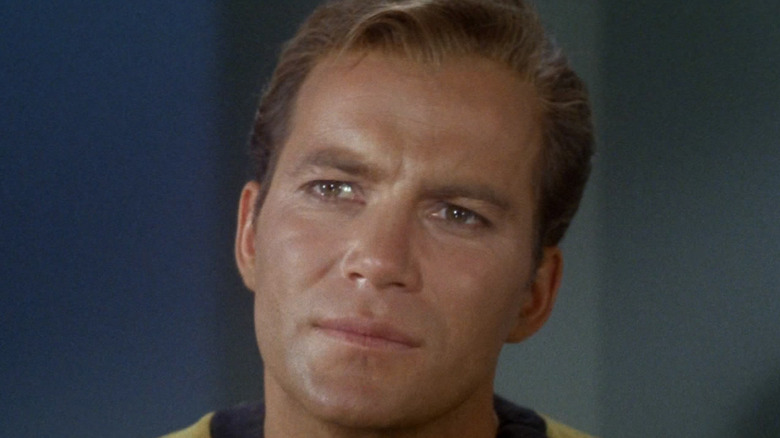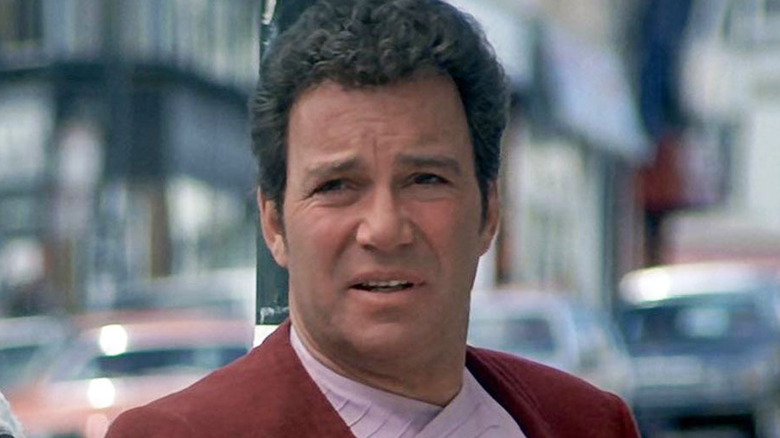What Star Trek Fans May Not Know About William Shatner
Science fiction icon William Shatner has been a darling of American pop culture almost since the day he stepped foot on the Enterprise. From his time helming the Federation flagship to his Emmy-winning tenure on "Boston Public," William Shatner is an outsized personality who only gotten more respected as the years have gone by.
After he disembarked the Enterprise in 1969, he did some musical work, including "The Transformed Man," often cited as one of the worst albums of all time. He took the hits in with his trademark good humor, though, and eventually returned as Captain Kirk in the movies. In the 80s Shatner became a different sort of TV star as "T.J. Hooker" before joining "Rescue 9-1-1" in the 1990s and becoming a spokesperson for emergency safety. After he joined the cast of "The Practice" as the ego-mad Denny Crane, it was spun off into "Boston Legal." Then following a brief stint on a Twitter-inspired comedy, "S#*t My Dad Says," he joined the cast of another space-bound enterprise, riding into low earth orbit aboard Jeff Bezos' Blue Origin rocket in 2021.
"Star Trek" fans may think they know everything about the man behind their favorite captain, but we've compiled a list of things we think most Trekkies might not know about the man, the myth, and the legend that is William Shatner.
His family disapproved of his career
The stereotype of the "starving artist" is a valid one, and it's not uncommon for a creative professional to be met with resistance from friends and family when they enter their chosen field. William Shatner joined the list of those with disapproving parents when he decided to pursue acting.
"My father didn't want me to go into it," he said in an interview with the Sydney Morning Herald in 2018. "Young people are tantalized by the glamor of being an actor. The reality is you're grubbing along on starvation wages." Shatner's father wanted him to take a more "sensible" career, something with more stability and a more reliable financial future, given that he himself had struggled for much of his own career. He even suggested they go into business together. "My father said, 'Why don't you study business, and then you'll be equipped when you go into business with me?' He had a small men's clothing factory. I graduated from McGill University in Montreal with a Bachelor of Business Administration."
Despite his father's words, Shatner chose acting and landed his first role in 1951. Asked in the interview if there was any acting role that wouldn't be worth the glamor and fortune for him, the former "Star Trek" star gave a typically Shatnerian response: "I wouldn't be in a porno movie."
He's known as a prankster on set
William Shatner is known these days for his jovial personality, particularly on social media. Good-natured, wryly funny, he's always ready to shoot off a snarky joke on Twitter or respond to his critics with a tongue-in-cheek jab. This is nothing new it seems, as according to Richard Donner, director of the "The Twilight Zone" episode in which Shatner appeared, the actor played a terrifying prank on him while filming "Nightmare at 20,000 Feet."
According to Donner, he was returning from a coffee break during filming when he saw Shatner apparently engaged in a fistfight with a crew member on the body of the airplane they were using to film. Before he could intervene, he saw the actor fall off the wing and strike the concrete below. "I thought he was dead, man. And I came running up and I grabbed him ... and then everybody's standing around laughing." Shatner and the crew had used an articulated dummy to prank their director.
And this wasn't the end of his practical jokes, either. According to his "Star Trek" co-star Leonard Nimoy, Shatner stole his bike and locked it to a fire hydrant. The reason? In a joint on-stage interview Shatner claimed "every time they called 'Lunch,' you'd get on your bike and bicycle down to the commissary and get to the head of the line!"
He can't do the Vulcan salute
The Enterprise, photon torpedoes, Klingons, "Beam Me Up Scotty!" These are just some of the iconic elements from "Star Trek" that have seeped into the public consciousness. One of the most famous, though, may be Mr. Spock's famous "Live Long And Prosper" greeting, and the accompanying hand gesture. First appearing in the second season premiere, "Amok Time," the gesture was suggested and created by actor Leonard Nimoy himself, as he felt the half-alien first officer should use some kind of traditional greeting when meeting one of his fellow Vulcans. Nimoy based the gesture on the priestly blessing performed by Jewish Kohanim, or priests.
Unfortunately, the Vulcan salute isn't as easy to perform for some as it was for Nimoy, and Shatner is one of those who has long struggled to make the simple hand gesture. He famously couldn't pull it off on "The Tonight Show With Conan O'Brien" in 2009, and even as recently as 2020 he confirmed that he still can't perform the "Live Long And Prosper" salute, more than fifty years after the original episode's first airing. In March of that year, he appeared as a guest on "Star Trek: The Cruise," an annual floating "Star Trek" convention, and he remarked that thanks to the then-emerging coronavirus, guests were being encouraged not to shake hands but to use the traditional Vulcan greeting, to which he tweeted in response, "what if you cannot do it?"
He sent a message to Discovery
Fans will pay big bucks to get a phone call or recorded message from their favorite actors and on-screen heroes. In fact, on the personalized celebrity video app "Cameo," fellow "Star Trek" alum star Jeri Ryan charges $345 for the privilege. In 2011, it was a different spacecraft called 'Discovery' that got a surprise call from the original star and captain of the Enterprise, William Shatner.
In a press release from NASA on the morning of March 7th, the space agency announced that the crew of the space shuttle Discovery received "a star-studded wake-up call" from Captain Kirk himself on the eve of its final mission. "These have been the voyages of the space shuttle Discovery," said the pre-recorded message from the actor, which paid homage to the iconic opening words of the original "Star Trek" TV series. "Her 30-year mission: to seek out new science, to build new outposts, to bring nations together in the final frontier, to boldly go and do what no spacecraft has done before."
In the final days of the Discovery's mission in space, NASA held a contest to choose two songs for the astronauts to wake up to on the morning of their last flight. Shatner's opening monologue, set to the "Star Trek" theme, won the contest with 27% of the vote.
He publicly called The Next Generation a mistake
When the "Star Trek" movies became big hits theaters in the 1980s, Paramount knew the time was right for a revival of the franchise on the small screen, but nobody had ever succeeded at bringing back such an iconic show, so there was still a lot of uncertainty and trepidation. When "Star Trek: The Next Generation" was announced in the fall of 1986, it came as a shock to everyone, especially to the franchise's biggest star, William Shatner.
Fans were up in arms over the news that this new series would not be including Kirk, Spock, McCoy, Sulu, Uhura, and the crew of the original Enterprise. The outcry was swift and dramatic, and it didn't help matters when William Shatner openly criticized the studio for making a new "Star Trek" show without him. Putting gasoline on an already raging fire, Shatner told "Starlog" magazine, "to call a series 'Star Trek' that doesn't have the cast and the ship in it is an error. The error seems to me to be over exposure of the "Star Trek" name and the possibility of not having the "Star Trek" quality we've become accustomed to. It remains to be seen." He eventually relented on his criticism of the show once it proved to be a hit, and happily starred alongside the crew of the Enterprise-D in "Star Trek: Generations."
He developed his signature style on Broadway
Many actors get their start in theater, and many actors develop their talent on the stage. Famously, Avery Brooks– Captain Sisko on "Star Trek: Deep Space Nine"– had a very Shatner-like style of acting with stop-and-start speech patterns– particularly when he got angry– that he developed in the theater (Brooks was also a Professor of Theater at Rutgers for many years).
That trademark stop-and-start cadence that audiences so closely identify with Shatner, where he seemingly emphasizes words at random, is as iconic as the Enterprise itself. Parodied more times than we care to count, it's one of the actor's most recognizable signatures, and like Brooks, he developed it on the stage. In a 2001 article in the Washington Post, the newspaper sat down with the larger than life Shatner, where he opened up about how his vocal calling card came to be. During the production of the Broadway play "The World of Suzie Wong" in 1958, Shatner and his castmates struggled to keep the viewers' attention, as members of the audience often didn't return after the usual intermission. When things were looking bleak, Shatner took it upon himself to grab their attention and keep them from leaving — yelling his lines, emphasizing what he felt were key phrases — and apparently, it worked. Shatner became something for the audiences to watch, a fascinating acting marvel, and with that, he had his signature style.
He was banned from the Tonight Show
Many celebrities have been banned from making appearances on live television shows. From Sinead O'Connor and Vince Vaughn to Dax Shephard and Madonna, these celebrities are usually barred because of profane language, problematic speech, or some other kind of bizarre, uncontrollable behavior that producers fear they might repeat.
The actor behind Captain Kirk isn't known for his extreme behavior, violent tendencies, potty mouth, or controversial takes, so it might come as a surprise to "Star Trek" fans to learn that William Shatner himself was once banned from "The Tonight Show," by no less than the legendary Johnny Carson himself. Did he flip a table and threaten the host? Did he moon the audience or insult the Catholic church? Not exactly. It was actually something much more mundane: talking too much.
In his book, "Shatner Rules: Your Guide to Understanding the Shatnerverse and the World at Large," Shatner revealed the juicy nugget of late-night talk show gossip, saying that "I was even banned from Carson after a mid-1980s appearance where I talked too much and monopolized our discussion. It seems some of these talk show hosts prefer to be the ones who get all the laughs." Eventually, he did return to "The Tonight Show" after Carson's departure from the long-running late-night variety series, with appearances opposite later hosts Jay Leno, Conan O'Brien, and Jimmy Fallon.
He made them change the script for Star Trek II
Over the years many stories have surfaced of how Shatner had peculiar demands on the set of "Star Trek," such as George Takei's claims that he wanted stories focused around his own character, at the expense of his costars. So when you learn that Shatner was unhappy with the original script to the celebrated "Star Trek II: The Wrath of Khan" — and the reasons why — it may not come as a surprise.
In an interview with StarTrek.com, director Nicholas Meyer discussed his frustrations with Shatner's dislike of his script. "Bill Shatner didn't like the script at all, and I was very floored by this because everybody else did like it. ... When he left, I was in a real depression."
Despite his shock and sadness at hearing that his star actor was dissatisfied with all of the hard work he had put into the script, Meyers was undeterred, and discussed the situation with Harve Bennett. The producer told him "'Well, you know, just a minute. If you parse this into bite sizes, it basically boils down that he wants to be the first man through the door.' So, I could understand that." Meyers suddenly saw eye-to-eye with Shatner's problems, and he returned to the typewriter to make some fixes to accommodate the captain's needs. "I went back and 24 hours later I'd done a rewrite, and he was very pleased."
His daughter appeared in a Star Trek episode
Episodes of "Star Trek" and its many spinoff series are known for hiding a wealth of easter eggs and references for diehard fans to find. Whether it's a reference to an older episode, a lesser-known character popping up on another show, or just a passing mention of an event from Trek's past, fans love finding little hidden gems. Sometimes the easter eggs are for the actor's, too, and in the classic "Star Trek" episode "Miri" from 1966, there are two that audiences probably didn't pick up on at the time.
In the episode, the Enterprise picks up a message from a planet called "Miri," a near exact duplicate of Earth, and populated by a people known as the "Onlies" – the remaining survivors of a global annihilation that left only the children alive. Playing two of the children in the episode were Shatner's two daughters, Lisbeth and Leslie. It was a rare chance for Shatner to act alongside his daughters, and one he couldn't pass up. They weren't the only famous children on set that day, as Scott Whitney, son of actress Grace Lee Whitney (who played Yoeman Rand), and Gene Roddenberry's two daughters Dawn and Darleen also appear.
He directed traffic as T.J. Hooker
In his book "Up Till Now: The Autobiography," William Shatner described two different traffic incidents that he helped sort out. The first, when he and his wife were on their way to the Oscars, described a situation he witnessed while driving where two other cars were in the midst of a road rage incident. He witnessed two drivers leave their vehicles, likely to engage in some old fashion fisticuffs, but Shatner was having none of it, and he leaped from his car and grabbed one of them. Immediately, he said, the driver recognized him, shouting in amazement "Captain Kirk!" According to Shatner, the two starstruck men "instantly relaxed."
The second instance is even more remarkable, but he swears upon its truthfulness. During the production of an episode of his 1980's police action series "T.J. Hooker," Shatner — while in costume as a police officer — witnessed a traffic accident. He said he intervened and instructed one of the drivers to get back into their vehicle. "Get back in your car and move along," Shatner said he told the driver, "And he listened to me. I'm certain he didn't recognize me. I told the other driver, 'it's your fault. You got a little damage. Come on, move your car, you're blocking traffic.' He too got back in his car and did as I ordered. And just for an instant I'd felt the power of the uniform. It was an oddly educational experience."
He had his own DVD by mail service
Shatner has always been full of big, lofty ideas, and that didn't stop when he left the Enterprise. As DVD-by-mail services were proliferating in the mid-2000s, William Shatner decided to get in on what must have looked like a lucrative, can't-miss business model. In March of 2006, he launched the eponymously titled "ShatnerDVDClub," a subscription service that would provide members with a carefully curated selection of science fiction, action, and horror films on DVD, through the mail, ostensibly chosen by Bill Shatner himself. Surely his name attached to a new service in a booming cottage industry was a recipe for big success, right?
While it might seem like an odd idea in hindsight, who knows what incredible plans Shatner may have had for the service: expansion into Europe, and beyond? More choices from different genres? A "Nimoy DVD Club" sister site? Sadly we'll never know, because the service shuttered its doors at the end of that same calendar year. In just under 10 months of existence, Shatner's self-named service came to a close, citing rising prices from its distributors. In its final press release, it said that its "partners cannot continue to provide these movies at the current low prices." Thankfully, Shatner and the service did right by their (relatively few) subscribers and sent every member the entirety of their remaining movies in a single, final package.
He received vials of horse semen in his divorce
William Shatner and his now ex-fourth-wife Elizabeth Martin officially divorced in 2020, after 18 years of holy matrimony. Once the lawyers negotiated the division of their assets, it was decreed that Martin would receive ownership of their home in Kentucky, while the former "Star Trek" captain would leave space dock with the couple's supply of horse semen. It may seem like an odd thing to receive in a settlement, but Shatner's love of horses is well-documented, and he was also a breeder with a large farm on the property of what is now his former Kentucky home. According to reports on Fox News, Shatner and Martin divided up ownership of their four horses, with Shatner being awarded custody of Renaissance Man's Medici and Powder River Shirley, and his ex-wife getting to keep the pair called Belle Reve's So Photogenic and Pebbles. In addition to the two horses, Shatner was given the entirety of the couple's horse breeding equipment and "all horse semen" according to documentation.
Martin also received the farm where they raised and bred horses as part of their divorce settlement, much to Shatner's chagrin. It may seem like he lost a lot in the split, but don't worry about Bill: his pre-nuptial agreement apparently included the provision that he would keep all of his royalties from his part in the "Star Trek" franchise.
He sold his kidney stone for $25,000
GoldenPalace.com is an online casino that is known for its odd purchases at auctions, which it uses to generate publicity, perhaps most notably the cheese sandwich said to display the image of the Virgin Mary. It's an odd business practice, but one that's seemingly paid off in terms of the wanted publicity.
In 2006, Golden Palace decided to get in on the world's love of William Shatner, and it did it for a good cause, too. According to CBS News, the online casino paid the actor $25,000 to purchase his passed kidney stone, with all of the proceeds going to Habitat for Humanity, a charity that builds houses for those in need. "This would be the first Habitat for Humanity house built out of stone," said the president of Julien's Auctions, who oversaw the sale. According to Shatner, the massive stone was so big "you'd want to wear it on your finger." In his typical blustery fashion he also claimed that "if you subjected it to extreme heat, it might turn out to be a diamond."
